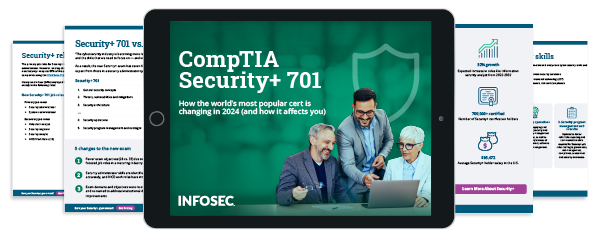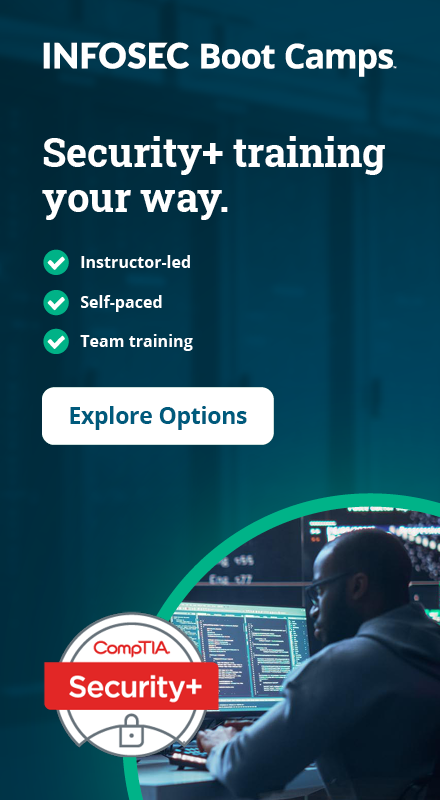Top 25 Security+ interview questions: Master your job interview
The CompTIA Security+ certification is a globally recognized certification that covers the standard skills and knowledge for an IT cybersecurity career. In the cybersecurity field, this is an important certification as it covers a wide range of topics, including network security, compliance, applications, data, hosting, access control, identity management, cryptography and more.
Not only is CompTIA Security+ certification vendor-neutral, but many entry-level cybersecurity employers prefer candidates with this certification on their resume. It also lays the foundation for more advanced certifications because of the broad security topics it covers for a wide variety of industries and applications.
In this article, we'll discuss the top interview questions hiring managers ask of Security+ holders and tips for answering those questions. We'll also provide context on the Security+ certification and why it's so valued among employers.
If you're considering furthering your cybersecurity career, the CompTIA Security+ certification is a valuable, foundational, globally recognized certificate. For more information on the Security+ exam, get your free Security+ ebook and webinar.

The evolving landscape of cybersecurity in 2025
Cybersecurity is a rapidly evolving landscape as criminals become more sophisticated, companies' infrastructure becomes more complex, and huge amounts of sensitive data are stored in the cloud. As more vulnerable, sensitive operations and information are online, these structures need to be increasingly secure. CompTIA Security+ and similar certifications are growing in importance as the need for skilled cybersecurity professionals increases.
In fact, 13% of all U.S. cybersecurity job openings list Security+, and 24% of the total employed U.S. cybersecurity workforce is Security+ certified, according to CyberSeek and CompTIA.
CompTIA Security+ helps enhance career prospects, demonstrates a commitment to continuous learning and development, and can help your résumé stand out.
Understanding the CompTIA Security+ examination
The CompTIA Security+ exam is graded on a scale of 100 to 900, with 90 questions to complete in 90 minutes. Passing scores are typically around 750, and questions are multiple-choice, drag-and-drop and performance-based. The key areas of knowledge include threat attacks and vulnerabilities, technologies, network architecture, identity and access management, risk management, cryptography and public key infrastructure, network security and compliance.
Become a SOC Analyst: get Security+ certified!
More than 47,000 new SOC analysts will be needed by 2030. Get your CompTIA Security+ to leap into this rapidly growing field — backed with an Exam Pass Guarantee.
Top CompTIA Security+ interview questions
Take a look at some sample CompTIA Security+ interview questions below.
1. What are the 5 Cs of cybersecurity?
The 5 Cs of cybersecurity are change, continuity, cost, compliance and coverage. All of these techniques work together to help businesses safeguard their network and improve business continuity. In this answer, address the basic concepts and elaborate on why these five areas are significantly important. They represent foundational pillars that any organization can build an effective cybersecurity policy.
2. What is encryption, and how is it used?
Encryption is a communication transmission method that converts data into a secret code that can only be unlocked with a unique key. It's used to protect data from being compromised or stolen. Interviews are looking for a thorough understanding of encryption basics, so explain the definition while also providing a scenario in which you implemented encryption methods.
3. What do you think about the evolving cybersecurity landscape and new threats, including ransomware-as-a-service and supply chain attacks?
This question aims to assess your learning and development around new threat vectors, so mention how you stay on top of evolving tactics. Walk through any real-life applications when it comes to combatting ransomware, and explain your commitment to ongoing professional development through certifications, workshops or training.
4. Do you believe in zero-trust security, and how do you implement this?
The concept of zero trust requires all users to be continuously authenticated and validated before entering a company's network. It treats each individual user as a threat until verified otherwise. Explain how this model offers enhanced visibility and security, especially in large enterprise organizations with thousands of users accessing sensitive information around the globe. Walk through an example of implementing enhanced security measures in a previous role.
5. What is threat intelligence, and how does it improve overall security posture?
Threat intelligence uses evidence-based information about potential cyberattacks to identify and mitigate potential threats. It works to safeguard company assets, systems, data and infrastructure. In this answer, mention how cybersecurity is constantly evolving and becoming more sophisticated, leading to threat intelligence offering a comprehensive view of where attacks are coming from and what tactics criminals are using.
6. Explain the potential security challenges of 5G technology.
Interviewers are looking for you to understand evolving technologies and consequential threats. They're also looking for out-of-the-box, critical thinking. Security challenges of 5G technology include IoT device vulnerabilities, location tracking and personal privacy concerns, and extensive personal data collection.
7. What is cross-site scripting?
Another standard definition question assessing your basic knowledge, cross-site scripting occurs when an attacker can inject executable code within JavaScript. This allows the database to be hacked through poorly scrubbed query string variables. Go beyond the basic definition answer by explaining a time you worked with a live cybersecurity incident and how you mitigated it.
8. What is the purpose of a firewall?
The goal of a firewall is to filter network traffic, allowing approved users access and blocking suspicious or fraudulent activity. Interviewers are looking for a basic understanding of fundamental cybersecurity definitions and concepts.
9. Explain the principles of defense and how segmentation supports network security.
Network segmentation divides a larger company infrastructure into smaller, more isolated segments. This creates an additional layer of defense as it isolates an active attack before it spreads. Tie this into an explanation of the zero-trust security model and how these proactive techniques have benefited your work in the past.
10. What are examples of common network-based attacks, such as DDoS attacks, and how would you mitigate them?
In this answer, explain that a distributed denial of service (DDoS) attack aims to disrupt normal traffic to a website. It's a non-intrusive attack meant to flood the network servers and overwhelm them, making them inaccessible. Valid answers for limiting DDoS attacks include attack surface reduction through techniques like network segmentation, firewalls, traffic monitoring, and building a business continuity and disaster recovery plan.
11. What is an Intrusion Prevention System (IPS), and how does it differ from a firewall? When would you implement it?
An IPS monitors inbound traffic and notifies an administrator of a potential attack. Firewalls perform specific actions like blocking and filtering traffic. IPS works to detect anomalies and often works in conjunction with firewalls. In this answer, walk through a scenario where you implemented two security tools to complement each other and work together.
12. Organizations are increasingly integrating IoT devices into their networks. What security practices would you implement around these devices?
IoT device security is critical as employees are working from home and from multiple devices in potentially unsecure locations. In this answer, identify specific strategies like device management, multi-factor authentication, remote patching and remediation, encryption protocols, penetration testing and endpoint security tools. This is a great question to address tactical strategies and demonstrate your expertise as well as your knowledge of emerging challenges.
13. What is an ACL?
An Access Control List (ACL) is a specific set of rules for filtering network traffic. It grants or denies individual users or systems from files or applications. This is another way to supports network segmentation, and this question provides another opportunity for you to talk about security postures working together.
14. Describe role-based access control.
Role-based access control is another way of improving network segmentation, restricting users' access based on their individual jobs. It allows only the permissions necessary to do their job and is a policy–neutral mechanism around roles and privileges. Walk through the success of role-based access control implementation and any key metrics you measured.
15. Describe network hardening techniques you would use.
Depending on the organization's size and industry, this answer might vary, but it's a great opportunity to cover fundamental practices for any organization. These techniques include proper firewall monitoring, remote access points, encryption techniques, endpoint security, penetration testing and more. Make sure your specific answer addresses the challenges of that organization's industry, getting specific for manufacturing, retail, healthcare, government agencies and more.
16. What could you use to defend against multiple login attempts?
Valid answers for defending against multiple login attempts include strong password policies limiting login attempts, using multi-factor authentication and strengthening firewalls. This is an opportunity to provide specific recommendations for that company's industry and size again.
17. Describe a signature-based IDS.
A signature-based intrusion detection system identifies known threats through a pre-programmed list of potential bad actors. When answering this question, compare signature-based IDS to anomaly-based intrusion systems, which alert network administrators of any type of threat. Both are valuable types of protection, but signature-based is the most common and traditional method.
18. How would you implement endpoint security for a company with a globally distributed workforce using a mix of company-owned and personal devices?
For this question, interviewers want to see your specific strategy for an organization of their size, and even smaller businesses deal with the challenges of a distributed workforce. Discuss complex endpoint management and security tactical strategies as well as principles behind empowering employees on security training basics.
19. What would your strategy be for an effective patch management system for a large enterprise organization?
In this answer, detail the best practices of effective patch management, including centralized patch management solutions, a defined patch management policy, automated patching, maintenance windows, risk management, regular vulnerability scans and more. Also, address the unique challenges for a large enterprise organization with potentially legacy, traditional architecture that is routinely outdated.
20. Describe an ideal employee security awareness training program and how you would measure the success.
Human error is responsible for roughly 88% of data breaches, so a thorough plan for a successful security awareness training program is important to any employer. Mention metrics to measure, like participation rates, employee feedback, compliance metrics, security incident metrics and more.
Be ready for the SY0-701 exam
All the information you need to make sure you're ready to ace your Security+ exam in one free ebook.
21. In the event of a cybersecurity incident, what would be your mitigation plan?
First, address the need for a formalized, proactive incident response plan before a security breach even occurs. Then, describe a potential mitigation plan, including segmenting and isolating the attack, monitoring backups, and any other strategies for reducing downtime. Detail your plans to immediately remediate and restore the network to business as usual.
22. How would you use vulnerability scanning to assess potential inefficiencies and attack entry points into a network?
Vulnerability scans assess the target attack surface and classify potential security exploitations. In this answer, detail proactive approaches that close gaps before incidents even occur. Through these automated, high-level tests, vulnerabilities are identified in network architecture, endpoint devices and more.
23. How would you bring security protocols into a software development process?
A question like this aims to assess cross-collaboration skills and past projects. Explain how you would educate software development team members and provide frameworks and industry standards security models for them to follow. Offer strategies for employee training on secure coding practices and secure communication protocols.
24. Describe your strategy for mitigating phishing attacks.
In this answer, provide statistics on the popularity and rise of phishing attacks and how employees are, unfortunately, the greatest victims. As one of the most common types of cyberattacks, conduct awareness training, utilize phishing simulations, and emphasize protection protocols.
Tips for answering technical interview questions
Your interviewer might ask about specific networking devices like firewalls, hubs, routers, and switches, so make sure you're familiar with wireless technology and the best practices for securing them. Familiarize yourself with popular ports and protocols, and ensure you have a few resources and materials at hand to demonstrate your constant commitment to learning about cyber security.
Hiring managers are often looking for candidates with both existing technical skills and a desire to deepen their learning, so discuss specific projects you've taken on - even at home - to demonstrate a focus on proactive, hands-on experience.
When structuring answers, think of the "STAR" answer format to clearly articulate your thought process. This framework allows you to cleanly and succinctly walk through an example or best practice.
- Situation: Set the scene and give the necessary details of your example.
- Task: Describe what your responsibility was in that situation.
- Action: Explain exactly what steps you took to address it.
- Result: Share what outcomes your actions achieved.
The role of CompTIA Security+ in cybersecurity careers
As noted above, many cybersecurity positions request applicants to have their Security+ as a way to validate their skills.
While this is an entry-level certification, it builds the foundation for more advanced skills, training and jobs. CompTIA offers a series of certifications that follow Security+, including the defensive Cybersecurity Analyst (CySA+) and the offensive PenTest+ certifications. The Security+ builds a foundation that can lead to many different career paths, from working in a SOC to cybersecurity management to privacy and risk — and several other paths. Common career paths include network administrator, security analyst, systems administrator, IT auditor, compliance analyst, and more.
For example, this cybersecurity analyst position requires the CompTIA Security+ certification or the ability to obtain it within six weeks of hiring.
Preparing for your CompTIA Security+ interview
As cybersecurity rapidly evolves and job requirements change, make sure you're constantly staying up to date with trends and emerging technologies. Read this Cybersecurity interview tips free eBook for more tips on how to stand out, get hired, and confidently answer technical questions.
If you need practical, hands-on experience, explore home labs, CTFs, and interactive learning like Infosec Skills Cyber Ranges.
Explore CompTIA Security+
As one of the most widely recognized and esteemed certifications, the CompTIA Security+ certification helps professionals stand out in interviews and answer technical, practical questions with confidence. For professionals committed to continuous education in a rapidly moving field of cybersecurity, the CompTIA Security+ certification demonstrates a thorough understanding of theoretical technical knowledge and real-life applications.
To learn more about Security+, visit Infosec's informational hub, or check out TechExams and other online forums and communities for cybersecurity professionals. For more learning, watch the free webinar with Patrick Lane of CompTIA where he discusses the next exam, the ever-evolving job market, and how required skill sets are changing to stay relevant. All registrants will get a free Security+ ebook outlining all the exam changes.
Also, you can always learn on your own time from a live boot camp or on-demand training from Infosec.





